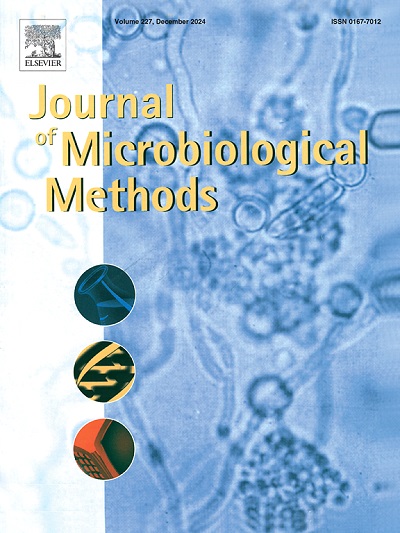通过比较基因组分析推断出胎儿弯曲杆菌亚种特异性 PCR 检测方法,以准确鉴定亚种。
IF 1.9
4区 生物学
Q4 BIOCHEMICAL RESEARCH METHODS
引用次数: 0
摘要
牛生殖器弯曲杆菌病(BGC)由胎儿弯曲杆菌性病亚种引起,是世界动物卫生组织(WOAH)通报的一种疾病。为有效控制 BGC,需要可靠地区分胎儿弯曲杆菌性病亚种(Cfv)和密切相关的胎儿弯曲杆菌亚种(Cff)。然而,现有的胎儿弯曲杆菌亚种分子鉴定测定缺乏灵敏度和特异性,无法根据表型或基因型差异区分胎儿弯曲杆菌分离物。此外,目前的生化亚种鉴定与胎生球虫菌株的基因组分化并不完全一致。在本研究中,利用大规模 BLAST 比值(LS-BSR)管道分析了 41 个已确定亚种的胎生球虫菌株的基因组序列,以确定 Cff 和 Cfv 的特异性序列。通过该分析,确定了编码天冬氨酸-半醛脱氢酶的 asd 基因,其中包含一个 6 bp 的 Cff 特异序列,而 Cfv 菌株的 asd 基因中不存在这 6 bp 序列。该序列被用于开发区分 Cff 和 Cfv 菌株的 PCR 检测方法。所开发的asd PCR检测方法对胎生球虫亚种的鉴定与菌株的基因组分类完全一致,建议用于BGC控制项目中胎生球虫亚种的分子鉴定。可使用包含 Cfvcatch 工具的网络界面对已测序基因组进行 asd PCR 评估,其中包括将受测基因组与参考胎生球虫基因组放在系统发生树中,以区分两个亚种并检测抗菌药耐药性基因。本文章由计算机程序翻译,如有差异,请以英文原文为准。
Campylobacter fetus subspecies specific PCR assays inferred from comparative genomic analysis for accurate subspecies identification
Bovine Genital Campylobacteriosis (BGC) is caused by Campylobacter fetus subsp. venerealis and is a notifiable disease to the WOAH (World Organisation for Animal Health). For an effective BGC control program, the reliable differentiation of Campylobacter fetus subsp. venerealis (Cfv) from the closely related Campylobacter fetus subsp. fetus (Cff) is required. However, the available molecular C. fetus subspecies identification assays lack sensitivity and specificity to differentiate C. fetus isolates based on their phenotypic or genotypic differences. Furthermore, the current biochemical subspecies identification is not fully congruent with the genomic differentiation of C. fetus strains.
In this study, the genome sequences of 41C. fetus strains with well identified subspecies, were analyzed with the large-scale BLAST score ratio (LS-BSR) pipeline to identify Cff and Cfv specific sequences. With this analysis, the asd gene encoding an aspartate-semialdehyde dehydrogenase was identified, which contained a 6-bp Cff-specific sequence, and this 6-bp sequence was absent in the asd gene of Cfv strains. This sequence was used for the development of PCR assays to differentiate Cff and Cfv strains. The C. fetus subspecies identification of the developed asd PCR assays was in full congruence with the genomic classification of strains and are recommended for molecular identification of C. fetus subspecies in BGC control programs.
The asd PCR can be assessed on sequenced genomes using a web interface containing the Cfvcatch tool, which includes placement of the tested genome in a phylogenetic tree with reference C. fetus genomes to distinguish the two subspecies and to detect antimicrobial resistance genes.
求助全文
通过发布文献求助,成功后即可免费获取论文全文。
去求助
来源期刊

Journal of microbiological methods
生物-生化研究方法
CiteScore
4.30
自引率
4.50%
发文量
151
审稿时长
29 days
期刊介绍:
The Journal of Microbiological Methods publishes scholarly and original articles, notes and review articles. These articles must include novel and/or state-of-the-art methods, or significant improvements to existing methods. Novel and innovative applications of current methods that are validated and useful will also be published. JMM strives for scholarship, innovation and excellence. This demands scientific rigour, the best available methods and technologies, correctly replicated experiments/tests, the inclusion of proper controls, calibrations, and the correct statistical analysis. The presentation of the data must support the interpretation of the method/approach.
All aspects of microbiology are covered, except virology. These include agricultural microbiology, applied and environmental microbiology, bioassays, bioinformatics, biotechnology, biochemical microbiology, clinical microbiology, diagnostics, food monitoring and quality control microbiology, microbial genetics and genomics, geomicrobiology, microbiome methods regardless of habitat, high through-put sequencing methods and analysis, microbial pathogenesis and host responses, metabolomics, metagenomics, metaproteomics, microbial ecology and diversity, microbial physiology, microbial ultra-structure, microscopic and imaging methods, molecular microbiology, mycology, novel mathematical microbiology and modelling, parasitology, plant-microbe interactions, protein markers/profiles, proteomics, pyrosequencing, public health microbiology, radioisotopes applied to microbiology, robotics applied to microbiological methods,rumen microbiology, microbiological methods for space missions and extreme environments, sampling methods and samplers, soil and sediment microbiology, transcriptomics, veterinary microbiology, sero-diagnostics and typing/identification.
 求助内容:
求助内容: 应助结果提醒方式:
应助结果提醒方式:


